Return of the Ivy League: After 18-Month Layoff, Live Game Production Is Back on Campus
With more than 1,400 events to be streamed to ESPN+, Ivy schools conjure up some new tricks
Story Highlights
540 days.
The sports world was hammered when the COVID-19 pandemic broke out in the early months of 2020. Sports leagues across the U.S. are still recovering both financially and in the sheer timing of their annual schedules.
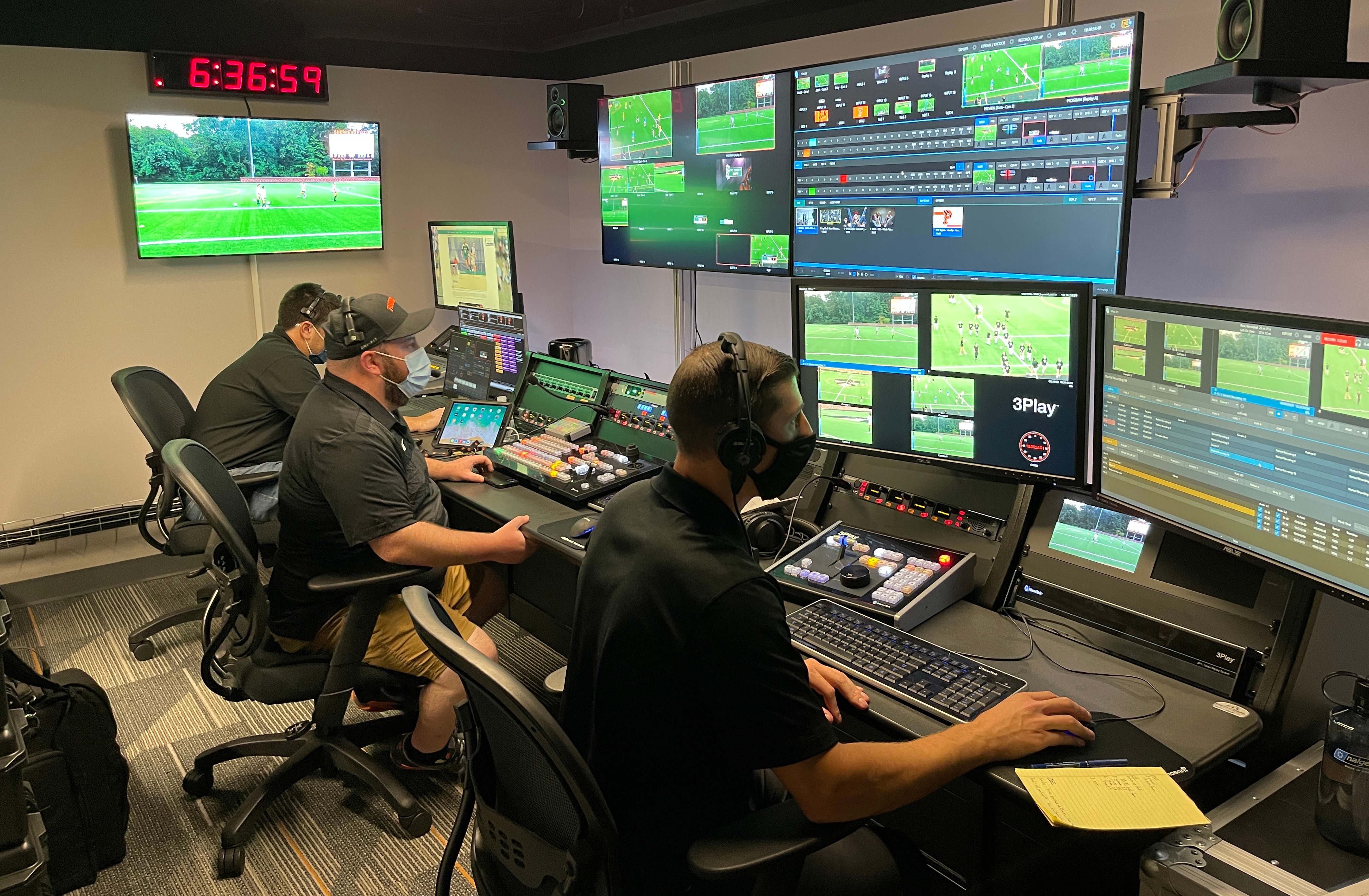
At Princeton University, one of three control rooms at the Levine Broadcast Center produces the school’s first live broadcast in 18 months for ESPN+, a women’s soccer game on Aug. 27. (Photo: Princeton Athletics)
One sports entity, however, that may have been hit hardest of all has been the Ivy League. The conference endured a shutdown of athletic events that stretched a staggering 18 months — approximately 540 days — before making a triumphant return on Friday, Aug. 27 with a slate of women’s soccer games. With it, sports-video–production teams across the conference’s eight campuses are back to doing what they do best: producing live games.
“It just feels normal again,” says Matt Panto, associate executive director, strategic communications and external relations, Ivy League. “While the pandemic is still very much a part of our daily lives, we’re talking about the things that we love and that we love to do. You can feel the energy on our campuses again. It’s why we do what we do. [We] couldn’t be more excited to get back.”
Although Ivy League member institutions were permitted to participate in NCAA-sanctioned events last year, the Ivy League had not hosted a conference-sanctioned athletics competition since baseball, softball, and lacrosse contests on March 5, 2020. Suddenly, Panto and video-production directors at each of the conference’s schools, who were used to producing a combined 1,000+ live events per year, were stymied.
The group has remained in constant communication despite working from their homes and with frustrating hiccups along the way, with academic season after academic season falling to the pandemic shutdown. According to Panto, the group even spent a large portion of last summer making comprehensive plans for what live production would look like under heavy COVID-based restrictions, only to see the entire 2020-21 year canceled.
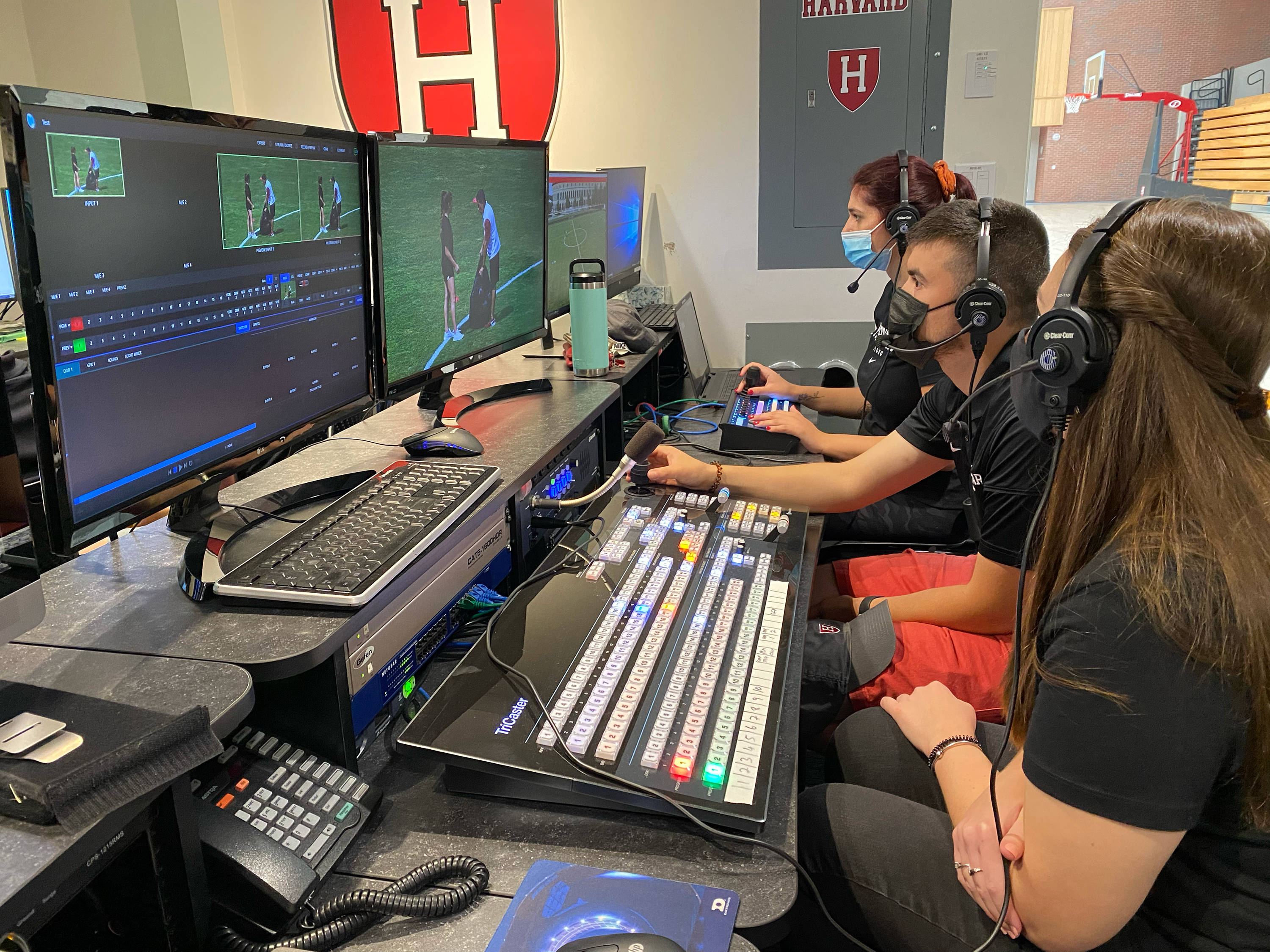
Harvard Athletics also returned to action with a women’s soccer game on Aug. 27. It was the department’s first game production done entirely over IP. (Photo: Harvard University Athletics)
Their efforts weren’t wasted, however. Many of the Ivy schools have spent the time sharpening their broadcast plans, updating their on-campus control rooms and infrastructures, conceptualizing fresh on-demand content ideas, and even instituting a new conference-wide file-sharing system powered by DropBox.
“We took a step back and discussed, when we do eventually come back, how will we be prepared for that moment?” says Panto. “Are you going to come back better than you left?”
An Ivy League broadcast-rights deal in place since 2018 covers live streaming of more than 1,400 events to ESPN+. Responsibility for live game production — with the exception of championship events — falls to the schools. So, as sports return this fall, the spigot will be turned back on full blast.
Two member institutions are hitting the ground running: Harvard University and Princeton University.
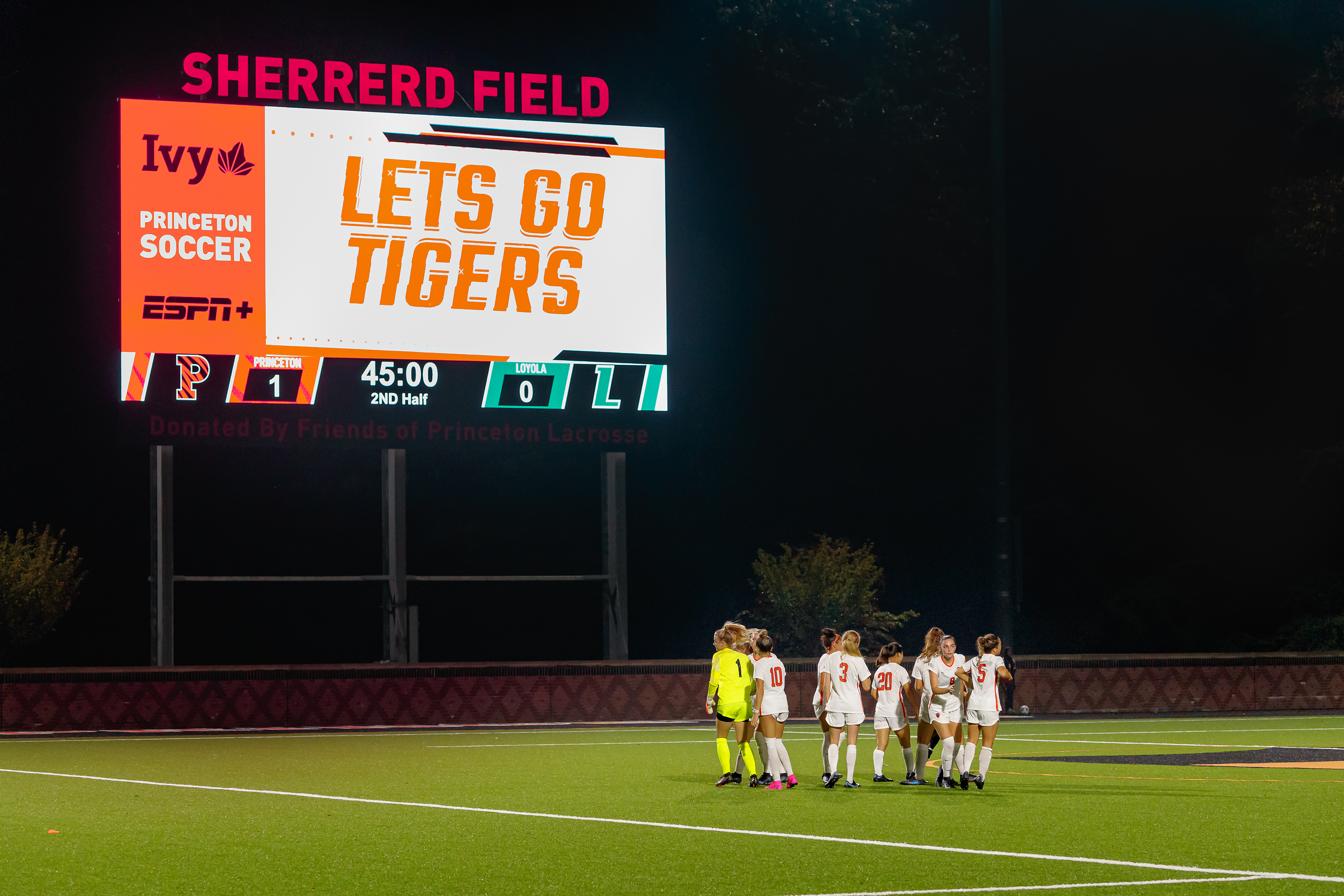
Princeton’s new Daktronics videoboard at 1952 Stadium debuted at the first live event after the shutdown. Although the stadium is traditionally the lacrosse venue, playing here allowed Princeton to produce the first videoboard show ever for a home women’s soccer game. (Photo: Princeton Athletics/Sideline Photos)
At Princeton, the Tigers welcomed sports back to campus this past weekend with a pair of three-camera women’s soccer productions at the 1952 Stadium, home to a brand-new 44- ft. by 28-ft. Daktronics videoboard, which is connected via fiber to the department’s centralized control room — the Levine Broadcast Center — about a half mile away at the historic Jadwin Gym. So last Friday’s soccer game marked not only the first live-streamed production since the pandemic but also the first videoboard show ever for Princeton women’s soccer.
Prior to the 18-month hiatus, Cody Chrusciel, assistant athletics director, multimedia and broadcast, Princeton Athletics, and his team had significantly expanded Levine Broadcast Center, adding two control rooms and a studio during summer 2019. Having less than a full academic year in the space, the Tigers used the shutdown to make some key tweaks: upgrading the switcher in the main control room from a NewTek TC1 to a TC2, installing a second NewTek 3Play replay system in the main control room, adding three BirdDog PTZ cameras in the studio (to provide flexibility in the studio during times of social distancing), purchasing a third AJT LiveBook system to support both broadcast and videoboard shows, upgrading to 10-GB switches in many facilities to better support the department’s largely NDI workflow, adding fiber drops and network ports at Princeton Stadium (football) to allow more camera and field-mic placements, and installing the new videoboard at 1952 Stadium.
“The layoff gave us time to dig in on our broadcast infrastructure,” says Chrusciel. “It also helped us get out in front of a few new athletic venues that are coming online in the next two or three years.”
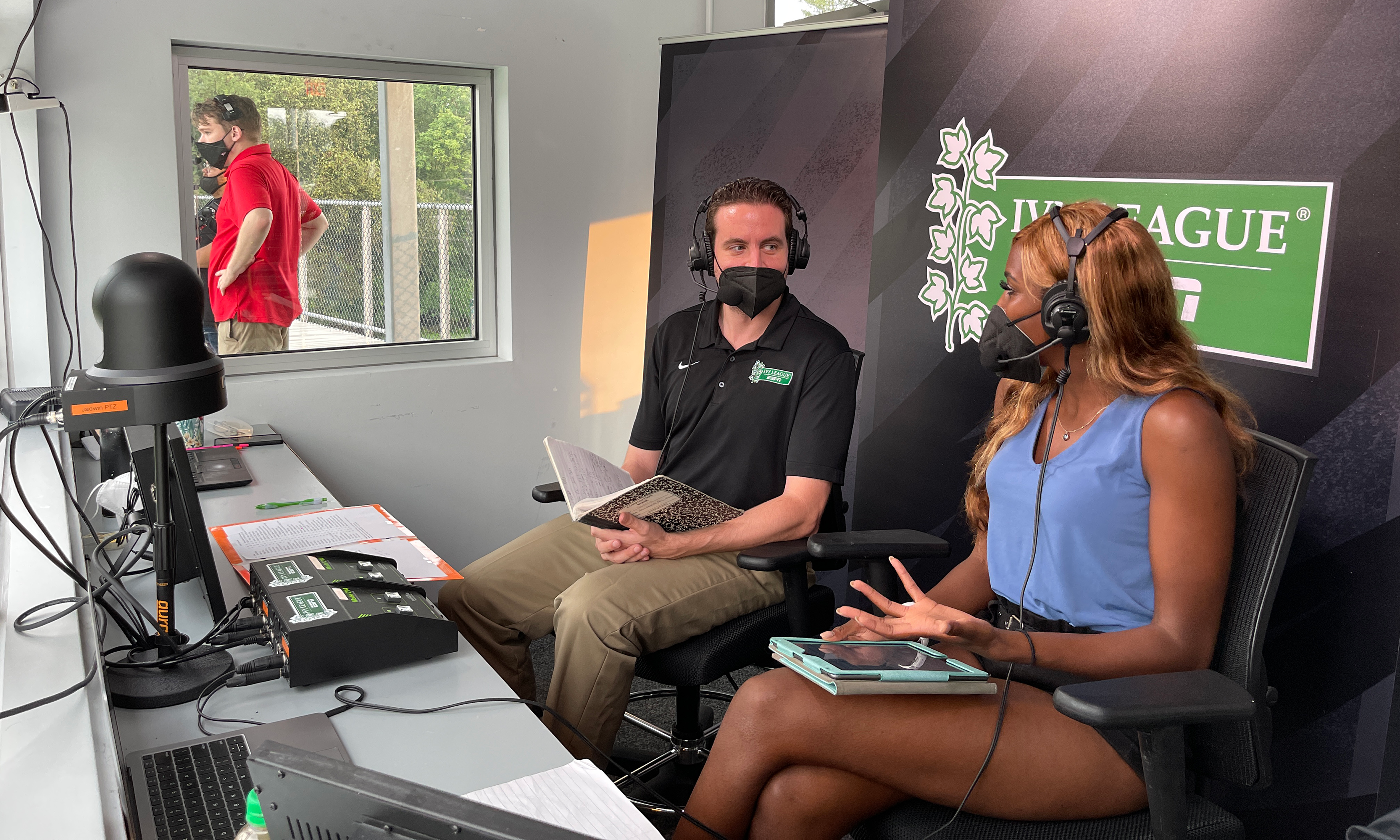
Announcers Jeff O’Connor (left) and Renee Washington were on the call as Princeton streamed the women’s soccer season opener on ESPN+. This fall, the Tigers will deliver approximately 90 shows to the Disney-owned streaming service as well as selected games to RSNs NBC Sports Philadelphia and SNY. (Photo: Princeton Athletics)
Men’s soccer and field hockey will be added to the ESPN+ mix this weekend, and then he and his team will produce five men’s water-polo matches over three days the following weekend. Between now and Thanksgiving weekend, Princeton expects to produce about 90 live shows for ESPN+ and for regional-sports-network partners like NBC Sports Philadelphia and SNY.
Meanwhile, the Harvard Crimson returned to action with a bang: a women’s soccer game on Aug. 27 was the department’s first production done fully in IP.
To support the effort, the largely student crew used two BirdDog A200 full-NDI PTZ cameras, Studio Technologies Model 204 Dante broadcaster stations, a BirdDog Studio NDI decoder (for talent monitor), and a SportzCast score bot for scoreboard data. The show was produced from the department’s centralized control room at its basketball arena, Lavietes Pavilion.
The video team at Harvard has been deploying IP technologies through the use of NDI since the opening of its current control room in 2017. According to Imry Halevi, assistant director of athletics, multimedia and production, Harvard University Athletics, however, the fully IP soccer broadcast is just the beginning of a commitment to do many live game productions this way. That means deploying NDI for video and Dante for audio and comms while bolstering the department’s arsenal of PTZ cameras.
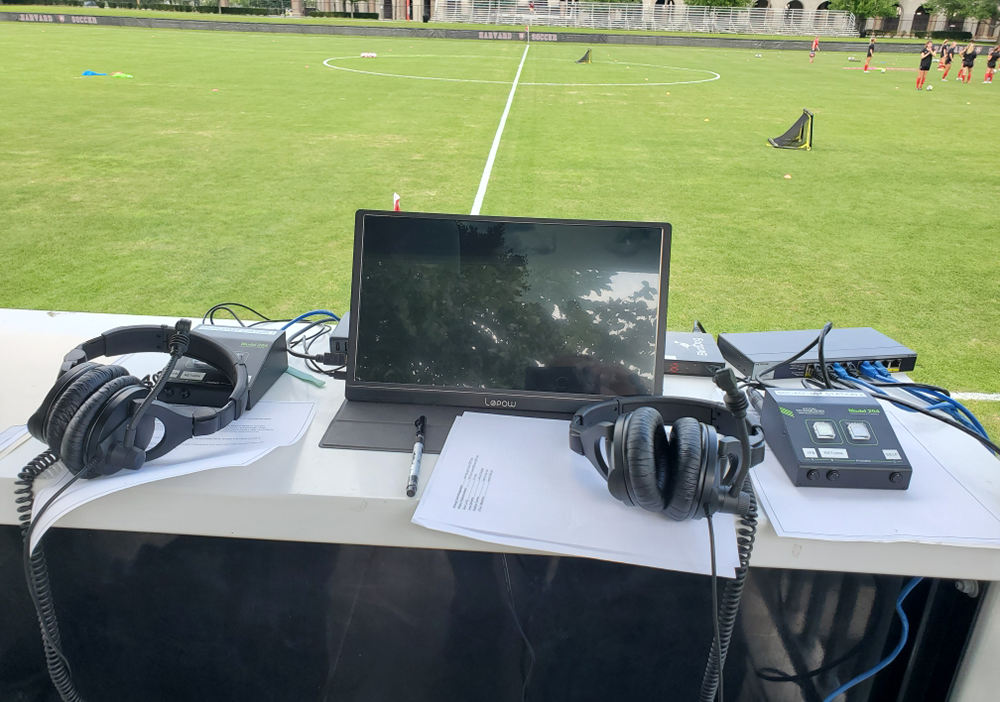
For the Harvard women’s soccer broadcast on Aug, 27, match announcers were onsite. The fully IP workflow, however, would have allowed them to call the game from anywhere. (Photo: Harvard Athletics)
“There are several reasons for that,” notes Halevi, whose team is expected to produce and broadcast 129 live events from the start of the season to the end of the 2021 calendar year. “First, we spend a lot of time setting up and breaking down equipment. Our soccer, field-hockey, rugby, water-polo, and volleyball facilities don’t have permanent control rooms. So, for every game, we have to spend hours building cameras and running cables. The way I see it, it’s wasted time. We have a limited crew and limited hours in each day. We can spend those hours either running fiber or working on storytelling and production elements. The more permanently installed PTZ cameras we can use, the less time we have to spend on the mechanics of production.
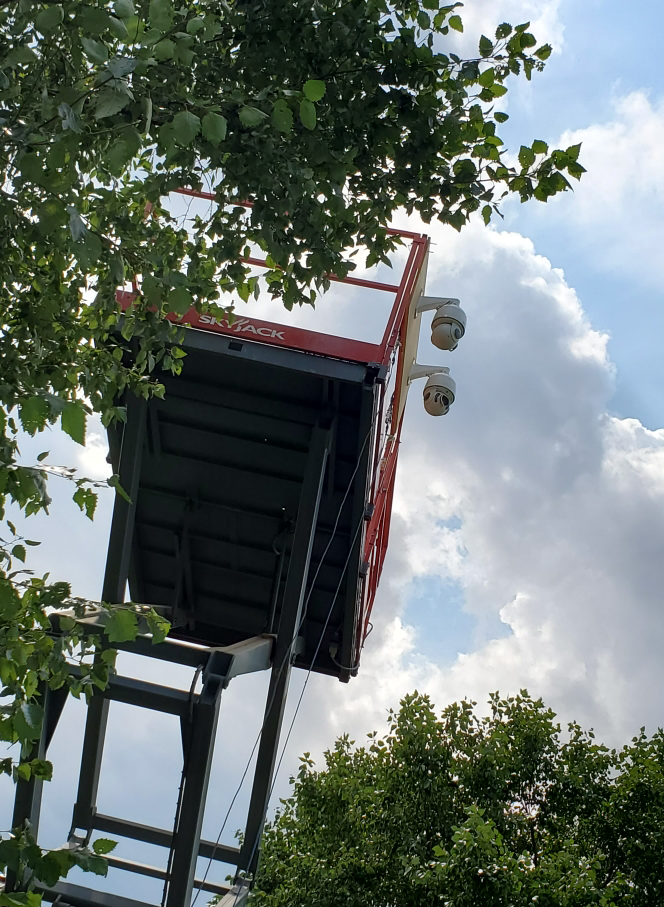
Harvard had two BirdDog A200 full-NDI PTZ cameras shooting the women’s soccer game. Halevi and his team are hoping to add more PTZs to their fall sports coverage across the board. (Photo: Harvard University Athletics)
“Second,” he continues, “we have 42 sports and more than 300 productions a year. Using PTZ cameras allows us to use the same crew for multiple games. If we have a soccer game and a rugby game three hours apart and all equipment is already in the venue, we can just reroute everything and produce different sports with the same crew from the same control room. It’s more efficient and less wasteful.”
Halevi also points out that it makes training up and working with a student crew more efficient. It’s worth noting that none of the students working on Harvard Athletics productions are Harvard students. They are all from other universities in the Boston area and have ambitions for (or, at least, an initial interest in) live sports production. So time with them can be limited, and removing tedious tasks like proper cable coiling can be bypassed in favor of the more exciting and creative prospect of building better on-air products.
It’s all these parts of live event production that have the likes of Halevi, Chrusciel, and their Ivy League brethren — Cornell’s John Lukach, Columbia’s Alex Oberweger, Dartmouth’s Ben Myers, Brown’s Rebekah Schoenecker, Yale’s Evan Ellis, and Penn’s Dan Wilde — excited to return to doing what their jobs are all about.
“I learned that live productions really are the fun part of this job,” says Halevi, who was named the 2021 recipient of the SVG College Pioneer Award. “Sure, conducting Zoom interviews and editing videos with two-year-old B-roll is fun, but there’s nothing that can compete with the storytelling that comes naturally from the energy of game days.”
